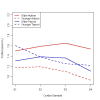Elevated cortisol during play is associated with age and social engagement in children with autism
- PMID: 20875126
- PMCID: PMC2955575
- DOI: 10.1186/2040-2392-1-13
Elevated cortisol during play is associated with age and social engagement in children with autism
Abstract
Background: The hallmark characteristic of autism is impaired reciprocal social interaction. While children find social interaction stress-reducing, many children with autism may find social interaction stress-inducing. The current study was designed to examine stress responsivity as measured by cortisol by comparing children with autism to neurotypical peers during an ecologically valid 20-minute playground paradigm.
Methods: The experiment involved sets of three children: a child with autism, a neurotypical child, and a confederate. Participants included 45 prepubescent males between 8 and 12 years of age (21 with autism and 24 neurotypical children).
Results: Children with autism showed fewer initiations (χ²(1) = 4.03, P = 0.044), rejected initiations from others more (χ²(1) = 7.10, P = 0.008) and spent less time interacting during motor (F(1,43) = 16.7, P = 0.0002) and cooperative (F(1,43) = 14.78, P = 0.0004) play. Repeated measures analysis of the cortisol values revealed a significant model (χ²(4) = 22.76, P < 0.0005) that included time of measurement, diagnosis and age as main effects and an interaction between diagnosis and age. Thus, as age increased among children with autism, they experienced enhanced cortisol levels while age did not modify expected cortisol levels for typical children. Stress responsivity was associated with more peripheral equipment play for motor (χ²(3) = 12.3, P = 0.006) and cooperative (χ²(3) = 8.24, P = 0.04) play as well as reduced nonverbal social skills during motor (χ²(1) = 5.52, P = 0.018) and cooperative play (χ²(1) = 4.53, P = 0.033).
Conclusions: Overall, children with autism engaged in fewer social overtures and spent less time interacting than typically developing peers during play. The peer interaction paradigm resulted in significantly higher levels of cortisol in many children with autism. Distinct patterns emerged within the autism group based on developmental (older), biological (cortisol responder) and behavioral patterns (peripheral group interaction). The enhanced cortisol response was observed in children who voluntarily engaged in interaction; thus, it does not support the notion of a response to social threat. Rather, it appears to reflect attendant metabolic preparedness and enhanced arousal from engaging socially. The data suggest that many children with autism activate hypothalamic-pituitary-adrenal responses in relatively benign social situations, which appears to be a function of age and level of social engagement. The findings support the need to teach coping strategies in addition to fundamental social skills to youth with autism.
Figures




References
-
- American Psychiatric Association. Diagnostic and statistical manual of mental disorders, Fourth Edition, Text Revision (DSM-IV-TR) Washington, DC: American Psychiatric Association; 2000.
-
- Boucher J. Pretend play as improvisation: conversation in the preschool classroom. Br J Dev Psych. 1999;17:164–165.
-
- Pellegrini AD, Smith PK. Physical activity play: the nature and function of a neglected aspect of playing. Child Dev. 1998;69:577–598. - PubMed
-
- Farmer-Dougan V, Kaszuba T. Reliability and validity of play-based observation: relationship between the PLAY Behavior Observation System and Standardized measures of cognitive social skills. Educ Psych. 1999;19:429–440. doi: 10.1080/0144341990190404. - DOI
Grants and funding
LinkOut - more resources
Full Text Sources
Other Literature Sources

